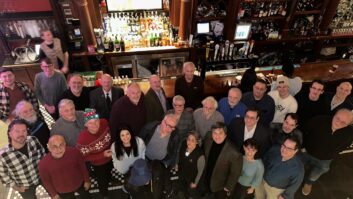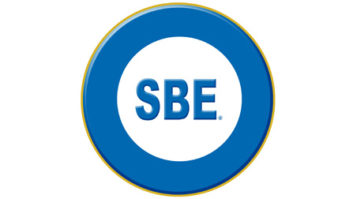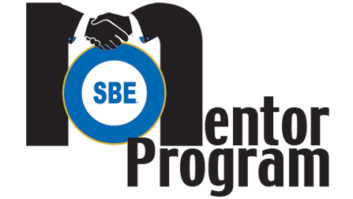
INDIANAPOLIS — Joe Snelson never envisioned himself in the role of party planner, but the new president of the Society of Broadcast Engineers will have a big hand in preparing that organization’s biggest celebration when it marks its 50th anniversary in 2014.
Snelson, vice president of engineering at Meredith Corp., begins his term with a clear focus on education. He will be inducted as president during SBE’s Annual Membership Meeting in Indianapolis at the end of October.
SBE is the professional organization of engineers in radio, television and related fields; it has approximately 5,300 members in 114 chapters across the United States; its footprint includes Hong Kong, Puerto Rico, Saipan and the U.S. Virgin Islands. The society also has affiliations with broadcast engineering groups in South Korea, Mexico, Brazil, the Philippines, India, Pakistan, Uruguay and Canada.
Snelson succeeds Ralph Hogan, who will remain on the board as immediate past president. Hogan told Radio World, “As I complete my tenure as SBE president, the biggest challenges that face SBE’s new president and essentially all broadcasters are the National Broadband Plan, spectrum auctions and the loss of retiring engineers from the industry at an alarming rate.”
The 63-year-old Snelson, who also chairs the SBE Frequency Coordination Committee and serves on the organization’s National Certification and Government Relations Committees, said education will draw a lot of his focus during his 12-month term.
“I agree with Ralph on the three challenges he identified,” he said. “One of my goals is to explore how we can get newcomers into the broadcast engineering field. But it’s not just getting newcomers into the business, but ensuring they can receive proper training in all facets of broadcast engineering they will be dealing with at a station.”
Challenges for members include the increasing importance for broadcast engineers to stay current on all the “technologies used for content delivery as well as how to improve the legacy over-the-air facility.”
He noted that SBE offers a diversity of educational materials ranging from publications to webinars and online classes. “Many of these have been added over the last several years. Keeping our educational program current and relevant serves as a good resource for newcomers into this business as well as those that have been in it for a while.”
Dissemination of information to chapters will also be a priority, as will the rollout of a mentorship program.
ENGINEERING EXPERIENCE
Snelson has a limited radio background — he was chief engineer of KCMO(AM) and KCEZ(FM) in Kansas City for about two years until Meredith sold the stations to Fairbanks in 1983 — but has a wealth of television engineering experience with Meredith. The broadcaster owns 11 full-power television stations and one low-power television station in various top 100 markets.
He began his broadcast engineering career in Los Angeles in the early 1970s at KHOF(TV). He graduated from Los Angeles City College with an Associate in Arts degree in broadcasting technology. He joined Meredith in 1980 at KCTV(TV) in Kansas City.
SBE continues to work on objectives laid out at a strategic planning meeting in June 2012. These include the need to revise its youth outreach; a possible rebranding of the organization; and ways to better train chapter leadership. Various committees are meeting to discuss which changes to adopt, he said.
The rebranding committee, chaired by Snelson, is considering ways to reflect changes in technology that affect the role and skill sets of a broadcast engineer. Snelson declined to comment on the committee’s work because it is ongoing; once the discussion on branding is concluded, a report will be submitted to the board of directors.
Of technological changes, Snelson sees the continued digital conversion of television and radio as a critical issue facing engineers.
“On the studio and delivery side it is crucial to construct infrastructure that can support future upgrades, higher bit rates and multi-channel operation. Without a doubt it is challenging to balance technology and a budget. It is not always easy trying to persuade non-technical management not to sacrifice the permanent on the altar of the immediate, especially when it comes to funding.”
Changing consumer consumption patterns, while not necessarily an engineering issue, mean broadcast engineers must be prepared to adapt and provide content accordingly, Snelson said. “This is why it is important to have a studio and delivery infrastructure capable of future changes.”
Meanwhile, industry discussion of AM revitalization has gained the attention of the society’s leadership.
“We have several radio broadcast engineers on the board of SBE who closely follow this subject, and we will be discussing how SBE can support AM radio revitalization initiatives that are in the best interest of the industry and ultimately our membership,” Snelson said.
Asked whether AM/FM radio should consider a mandated conversion to digital, Snelson said he lived through the mandated digital TV conversion and thinks any decision has to be made in the best interests of broadcasters.
“When government mandates are proposed, one needs to look closely at whom and what is driving it. Was it driven by an industry effort or was it due to political or budget pressures? … I consider myself privileged to have worked with some of the sharpest engineers in this business as we worked through the issues involved with conversion. It was through that input to the FCC that made the DTV conversion mandate a success.”
Snelson also said he has served on enough SBE committees to understand the demands on broadcast engineers facing limited budgets while juggling multiple facilities.
“Whether it is radio or television, we are seeing individuals having to operate or maintain multiple facilities. Some of our educational offerings talk about this subject. For example, I was a co-author of the revised Television Operators Handbook. We wrote a section in it that address automation and centralized operations.”
Radio and television both face increased regulatory and technical challenges such as increased noise floors and interference; he said engineers work constantly to provide reliability and high-quality service to their listeners/viewers and remain compliant with FCC regulations. Education and information-sharing can be helpful to those that face changing rules and regulations, he said.
LAS VEGAS SBE
Snelson, a member of the Las Vegas chapter, hopes to nourish local chapters during his tenure. “It’s part of our strategic planning. The strength of SBE lies in our chapters. Growing our local chapters and seeing increased participation from the local members is important.”
As for attracting newcomers, Snelson says, “Even with regulatory and business challenges facing our industry, this can still be a rewarding business.” However, drawing fresh talent remains difficult and complex.
“While SBE cannot control economy or station ownership decisions, we can and do provide various opportunities engineers can take advantage of to further enhance their self-development and potentially gain recognition from their employers. I am referring to the educational offerings, information sharing and networking through local chapters and the SBE program of certification in which an individual’s skills and expertise are recognized.”
SBE also recently created a mentoring sub-committee with the goal of allowing newcomers an opportunity to link up with a mentor to help them develop their careers, Snelson said.
The organization will release plans for its golden celebration in the months to come, according to Snelson. It will include an amnesty program, which runs through April 2014, for those that may have let their SBE certification lapse. The certification committee is allowing those who have let their certifications lapse between January 1999 and January 2012 to re-instate their certification without taking an exam. The organization plans to use the anniversary to demonstrate the significance of member contributions to broadcasting. A special anniversary logo and slogan are also possibilities, the group said.
Snelson, a Certified Professional Broadcast Engineer and 8-VSB Specialist through SBE, relocated to Las Vegas in 2003 and maintains an office at Meredith’s television station in Henderson, Nev. He added that the location makes attending the NAB Show “a dream, as I get to sleep in my own bed at night.”












